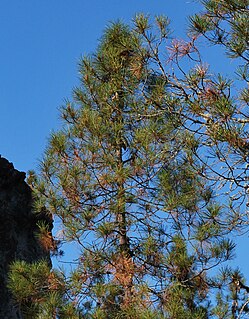Related Research Articles

The pygmy killer whale is a poorly known and rarely seen oceanic dolphin. It derives its common name from sharing some physical characteristics with the killer whale. It is the smallest cetacean species that has "whale" in its common name. Although the species has been known to be extremely aggressive in captivity, this aggressive behavior has not been observed in the wild.

The knobcone pine, Pinus attenuata, is a tree that grows in mild climates on poor soils. It ranges from the mountains of southern Oregon to Baja California with the greatest concentration in northern California and the Oregon-California border.

Agave attenuata is a species of flowering plant in the family Asparagaceae, commonly known as the foxtail or lion's tail. The name swan's neck agave refers to its development of a curved inflorescence, unusual among agaves. Native to the plateaux of central west Mexico, as one of the unarmed agaves, it is popular as an ornamental plant in gardens in many other places with subtropical and warm climates.

Banksia attenuata, commonly known as the candlestick banksia, slender banksia or biara to the Noongar people, is a species of plant in the family Proteaceae. Commonly a tree, it reaches 10 m (33 ft) high, but it is often a shrub in drier areas 0.4 to 2 m high. It has long, narrow, serrated leaves and bright yellow inflorescences, or flower spikes, held above the foliage, which appear in spring and summer. The flower spikes age to grey and swell with the development of the woody follicles. The candlestick banksia is found across much of the southwest of Western Australia, from north of Kalbarri National Park down to Cape Leeuwin and across to Fitzgerald River National Park.

The Asian gray shrew is a species of mammal in the family Soricidae. It is found in Bhutan, Cambodia, China, India, Laos, Malaysia, Myanmar, Nepal, Pakistan, the Philippines, Thailand, and Vietnam. It is one of the commonest species within its range and the International Union for Conservation of Nature has assessed its conservation status as being of "least concern".

Nicotiana attenuata is a species of wild tobacco known by the common name coyote tobacco. It is native to western North America from British Columbia to Texas and northern Mexico, where it grows in many types of habitat. It is a glandular and sparsely hairy annual herb exceeding a meter in maximum height. The leaf blades may be 10 centimetres (4 in) long, the lower ones oval and the upper narrower in shape, and are borne on petioles. The inflorescence bears several flowers with pinkish or greenish white tubular throats 2 to 3 centimetres long, their bases enclosed in pointed sepals. The flower face has five mostly white lobes. The fruit is a capsule about 1 centimetre long.
Helicia attenuata is a plant in the family Proteaceae. The specific epithet attenuata means "drawn out", referring to the leaf base.

Haworthiopsis attenuata, formerly Haworthia attenuata, commonly known as zebra haworthia, is a small species of succulent plant from the Eastern Cape Province, South Africa. As an ornamental, it is one of the most commonly cultivated of the Haworthiopsis species.

Crossotini is a tribe of longhorn beetles of the subfamily Lamiinae. It was described by Thomson in 1864.

Moechotypa is a genus of longhorn beetles of the subfamily Lamiinae.
Moechotypa dalatensis is a species of beetle in the family Cerambycidae. It was described by Stephan von Breuning in 1968. It is known from Vietnam.
Moechotypa sikkimensis is a species of beetle in the family Cerambycidae. It was described by Stephan von Breuning in 1936. It is known from India.
Moechotypa trifasciculata is a species of beetle in the family Cerambycidae. It was described by Stephan von Breuning in 1936. It is known from Vietnam.
Moechotypa adusta is a species of beetle in the family Cerambycidae. It was described by Pascoe in 1869. It is known from Cambodia, Vietnam, Laos, and Thailand.
Moechotypa coomani is a species of beetle in the family Cerambycidae. It was described by Pic in 1934. It is known from Laos, Cambodia, and Vietnam.

Moechotypa diphysis is a species of beetle in the family Cerambycidae. It was described by Pascoe in 1871. It is known from Russia, China, Japan, North Korea, and South Korea. It feeds on plants such as Ailanthus altissima, Juglans regia, Zanthoxylum simulans, and Quercus glauca.

Moechotypa formosana is a species of beetle in the family Cerambycidae. It was described by Pic in 1917. It is known from Taiwan.
Moechotypa suffusa is a species of beetle in the family Cerambycidae. It was described by Pascoe in 1862. It is known from China, Cambodia, Thailand, Laos, and Vietnam.

Moechotypa thoracica is a species of beetle in the family Cerambycidae. It was described by White in 1858. It is known from India, Borneo, Laos, Sumatra, Vietnam, and Java.
Moechotypa uniformis is a species of beetle in the family Cerambycidae. It was described by Pic in 1922. It is known from Vietnam.
References
- ↑ BioLib.cz - Moechotypa attenuata. Retrieved on 8 September 2014.